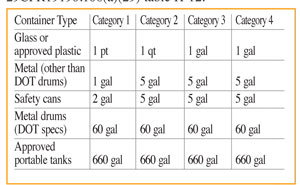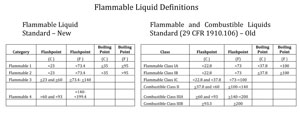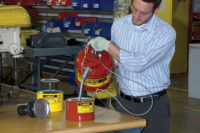OSHA’s proposed revised rules dealing with flammable liquids were published in the Federal Register volume 74, number 188 dated September 30, 2009. The proposals in response to the Globally Harmonized System of Classification and Labeling of Chemicals (or GHS) would change labor law in the U.S. The main elements of the hazard classifications are summarized as: physical hazards, health hazards and environmental hazards.

|
| Click to enlarge |
Squarely in the middle of Physical Hazards we read, “A flammable liquid is a liquid with a flash point at or below 199.4 degrees F (93ºC).” Substances and mixtures of this hazard class are assigned to one of four hazard categories on the basis of the flash point and boiling point. Flash point means the minimum temperature of a liquid at which sufficient vapor is given off to form an ignitable mixture with the air, near the surface of the liquid or within the vessel used. Boiling point means the temperature at which the vapor pressure of a liquid equals the surrounding atmospheric pressure.
Implementation schedule
There is no set international implementation schedule for the GHS. However, the U.S. published the final rule for implementation of GHS on March 26, 2012. The final rule requires product manufacturers to adopt the standard by June 1, 2015, and product distributors to adopt the standard by December 1, 2015. Workers must be trained by December 1, 2013.
OSHA finalized the new rule and significantly amended 29 CFR 1910.106 and 1926.152 effective May 26, 2012. The definition of a flammable liquid changed and the term combustible liquid was eliminated. These definitions had stood since OSHA’s birth in the early 70s.
The following notes apply:
1) When a Category 3 liquid with a flashpoint at or above 100ºF (37.8ºC) is heated for use to within 30ºF (16.7ºC) of its flashpoint, it shall be handled in accordance with the requirements for a Category 3 liquid with a flashpoint below 100ºF (37.8ºC).
2) When a Category 4 flammable liquid is heated for use to within 30ºF (16.7ºC) of its flashpoint, it shall be handled in accordance with the requirements for a Category 3 liquid with a flashpoint at or above 100ºF (37.8ºC).
These changes impacted, among others, both the industrial standard number 1910 and the construction standard number 1926. With the new nomenclature in mind, let’s examine how storage and handling are affected under both standards. Category 1 is a smaller population of liquids than class 1A. Categories 2, 3 and 4 now include a population of liquids that was once 1 and excludes 3B all together. The following are changes as they relate to safety cans and safety cabinets.
The maximum allowable size of containers and portable tanks is found in OSHA 29CFR1910.106(d)(2)(iii) table H-12:

|
| Click to enlarge |
In the past, class 3 liquids were covered by this table. There are no other significant changes, except the migration of liquids with a boiling point between 95ºF and 100ºF are defined in a less volatile category.
OSHA 29 CFR 1926.152(a)(1) states:
Only approved containers and portable tanks shall be used for storage and handling of flammable liquids. Approved safety cans or Department of Transportation approved containers shall be used for the handling and use of flammable liquids in quantities of 5 gallons or less, except that this shall not apply to those flammable liquid materials which are highly viscid (extremely hard to poor), which may be used and handled in original shipping containers. For quantities of one gallon or less, the original container may be used, for storage, use and handling of flammable liquids.
Safety cans
1910 and 1926 refer to safety cans. Exactly what is meant?
[1910] Shall mean an approved container, of not more than 5 gallons capacity, having a spring-closing lid and spout cover and so designed that it will safely relieve internal pressure when subjected to fire exposure. (1910.106(a)(29))
[1926] Means an approved closed container, of not more than 5 gallons capacity, having a flash-arresting screen, spring-closing lid and spout cover and so designed that it will safely relieve internal pressure when subjected to fire exposure. (1926.155(I))
Notice that the construction standard requires a “Flash-Arresting Screen.” The industrial standard does not. FM, one of the recognized approval agencies requires a screen and in fact tests to make certain the screen functions as a flame arrester, not simply as a filter. UL, also a recognized approval agency, does not test the screen. It is interesting that every manufacturer of safety cans in the U.S. offers a flash-arresting screen in all safety cans.
Storage cabinets
The section dealing with design, construction and capacity of storage cabinets, 29 CFR 1910.106(d)(3), remains unchanged other than referencing “categories” rather than “classes” and eliminating the mention of 3B liquids. Part 1926 of 29CFR follows the same pattern.
OSHA’s industrial regulations also address storage and use of liquids where use and handling is incidental to the principal business. 1910.106(e)(2)(i)“Application.” This subparagraph shall be applicable to those portions of an industrial plant where the use and handling of flammable liquids is only incidental to the principal business, such as automobile assembly, construction of electronic equipment, furniture manufacturing or similar activities.
(ii) “Containers.” Flammable liquids shall be stored in tanks or closed containers.
(a) Except as provided in subdivisions (b) and (c) of this subdivision, all storage shall comply with paragraph (d)(3) or (4) of this section.
(b) The quantity of liquid that may be located outside of an inside storage room or storage cabinet in a building or in any one fire area of a building shall not exceed:
(1) 25 gallons of Category 1 flammable liquids in containers
(2) 120 gallons of Category 2, 3 or 4 flammable liquids in containers
(3) 660 gallons of Category 2, 3 or 4 flammable liquids in a single portable tank.
Notes:
There is no real change here, except Class 3B liquids are no longer required to be in cabinets.
The language in 1926 applies everywhere on a construction site.
1926.152(b)(1)
Not more than 25 gallons of flammable liquids shall be stored in a room outside of an approved storage cabinet. For storage of liquefied petroleum gas, see 1926.153.
1926.152(b)(2)
Quantities of flammable liquid in excess of 25 gallons shall be stored in an acceptable or approved cabinet meeting the following requirements:
1926.152(b)(2)(ii)
Approved metal storage cabinets will be acceptable.
The threshold level of 25 gallons applies to all four categories.
Final use
Refer to 1910.106(e)(2)(II) in both the new and old standards. Editorial changes have been made to accommodate the revised nomenclature with no effect on operating procedures, for example:
New: (a) Category 1 or 2 flammable liquids, or category 3 flammable liquids with a flashpoint below 100ºF (37.8ºC), shall be kept in covered containers when not actually in use.
Old: (a) Flammable liquids shall be kept in covered containers when not actually in use.
Because “flammable liquids” in the old standard equates to category 1 or 2 or category 3 flammable liquids with a flashpoint below 100ºF (37.8ºC), no change in operations is called for, except liquids with a boiling point between 95ºF and 100ºF are defined in a less volatile category.
Changes throughout are primarily editorial. However, we have lost OSHA’s protective language covering liquids with flashpoint at or above 200ºF or 93ºC.
How do the fire codes address the issue? Do they mesh with the revised labor law? Find out in our follow-up article scheduled for publication in August.

